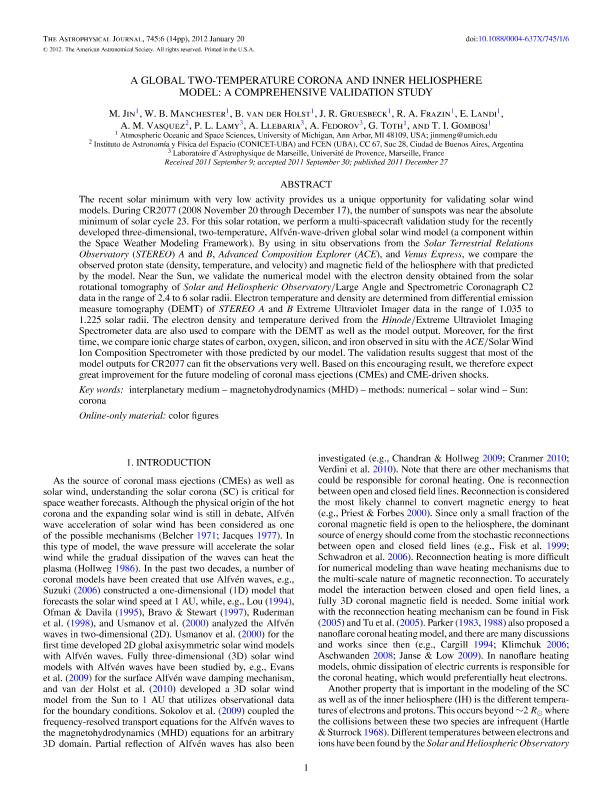Mostrar el registro sencillo del ítem
dc.contributor.author
Jin, M.
dc.contributor.author
Manchester, W.B.
dc.contributor.author
Van Der Holst, B.
dc.contributor.author
Gruesbeck, J.R.
dc.contributor.author
Frazin, R.A.
dc.contributor.author
Landi, E.
dc.contributor.author
Vasquez, Alberto Marcos

dc.contributor.author
Lamy, Philippe
dc.contributor.author
Llebaria, Antoine
dc.contributor.author
Fedorov, A.
dc.contributor.author
Toth, Gabor
dc.contributor.author
Gombosi, Tamas I.
dc.date.available
2019-05-21T15:00:48Z
dc.date.issued
2012-01
dc.identifier.citation
Jin, M.; Manchester, W.B.; Van Der Holst, B.; Gruesbeck, J.R.; Frazin, R.A.; et al.; A global two-temperature corona and inner heliosphere model: A comprehensive validation study; IOP Publishing; Astrophysical Journal; 745; 1; 1-2012; 6-20
dc.identifier.issn
0004-637X
dc.identifier.uri
http://hdl.handle.net/11336/76787
dc.description.abstract
The recent solar minimum with very low activity provides us a unique opportunity for validating solar wind models. During CR2077 (2008 November 20 through December 17), the number of sunspots was near the absolute minimum of solar cycle 23. For this solar rotation, we perform a multi-spacecraft validation study for the recently developed three-dimensional, two-temperature, Alfvén-wave-driven global solar wind model (a component within the Space Weather Modeling Framework). By using in situ observations from the Solar Terrestrial Relations Observatory (STEREO) A and B, Advanced Composition Explorer (ACE), and Venus Express, we compare the observed proton state (density, temperature, and velocity) and magnetic field of the heliosphere with that predicted by the model. Near the Sun, we validate the numerical model with the electron density obtained from the solar rotational tomography of Solar and Heliospheric Observatory/Large Angle and Spectrometric Coronagraph C2 data in the range of 2.4 to 6 solar radii. Electron temperature and density are determined from differential emission measure tomography (DEMT) of STEREO A and B Extreme Ultraviolet Imager data in the range of 1.035 to 1.225 solar radii. The electron density and temperature derived from the Hinode/Extreme Ultraviolet Imaging Spectrometer data are also used to compare with the DEMT as well as the model output. Moreover, for the first time, we compare ionic charge states of carbon, oxygen, silicon, and iron observed in situ with the ACE/Solar Wind Ion Composition Spectrometer with those predicted by our model. The validation results suggest that most of the model outputs for CR2077 can fit the observations very well. Based on this encouraging result, we therefore expect great improvement for the future modeling of coronal mass ejections (CMEs) and CME-driven shocks. © 2012. The American Astronomical Society. All rights reserved.
dc.format
application/pdf
dc.language.iso
eng
dc.publisher
IOP Publishing

dc.rights
info:eu-repo/semantics/openAccess
dc.rights.uri
https://creativecommons.org/licenses/by-nc-sa/2.5/ar/
dc.subject
Interplanetary Medium
dc.subject
Magnetohydrodynamics (Mhd)
dc.subject
Methods: Numerical
dc.subject
Solar Wind
dc.subject
Sun: Corona
dc.subject.classification
Astronomía

dc.subject.classification
Ciencias Físicas

dc.subject.classification
CIENCIAS NATURALES Y EXACTAS

dc.title
A global two-temperature corona and inner heliosphere model: A comprehensive validation study
dc.type
info:eu-repo/semantics/article
dc.type
info:ar-repo/semantics/artículo
dc.type
info:eu-repo/semantics/publishedVersion
dc.date.updated
2019-05-14T21:19:54Z
dc.journal.volume
745
dc.journal.number
1
dc.journal.pagination
6-20
dc.journal.pais
Reino Unido

dc.journal.ciudad
Londres
dc.description.fil
Fil: Jin, M.. University Of Michigan, Ann Arbor; Estados Unidos
dc.description.fil
Fil: Manchester, W.B.. University Of Michigan, Ann Arbor; Estados Unidos
dc.description.fil
Fil: Van Der Holst, B.. University Of Michigan, Ann Arbor; Estados Unidos
dc.description.fil
Fil: Gruesbeck, J.R.. University Of Michigan, Ann Arbor; Estados Unidos
dc.description.fil
Fil: Frazin, R.A.. University Of Michigan, Ann Arbor; Estados Unidos
dc.description.fil
Fil: Landi, E.. University Of Michigan, Ann Arbor; Estados Unidos
dc.description.fil
Fil: Vasquez, Alberto Marcos. Consejo Nacional de Investigaciónes Científicas y Técnicas. Oficina de Coordinación Administrativa Ciudad Universitaria. Instituto de Astronomía y Física del Espacio. - Universidad de Buenos Aires. Facultad de Ciencias Exactas y Naturales. Instituto de Astronomía y Física del Espacio; Argentina
dc.description.fil
Fil: Lamy, Philippe. Laboratoire D'astrophysique de Marseille; Francia
dc.description.fil
Fil: Llebaria, Antoine. Laboratoire D'astrophysique de Marseille; Francia
dc.description.fil
Fil: Fedorov, A.. Laboratoire D'astrophysique de Marseille; Francia
dc.description.fil
Fil: Toth, Gabor. University Of Michigan, Ann Arbor; Estados Unidos
dc.description.fil
Fil: Gombosi, Tamas I.. University Of Michigan, Ann Arbor; Estados Unidos
dc.journal.title
Astrophysical Journal

dc.relation.alternativeid
info:eu-repo/semantics/altIdentifier/doi/http://dx.doi.org/10.1088/0004-637X/745/1/6
Archivos asociados
